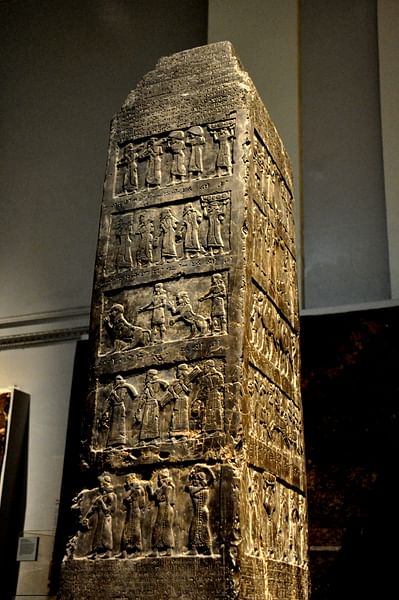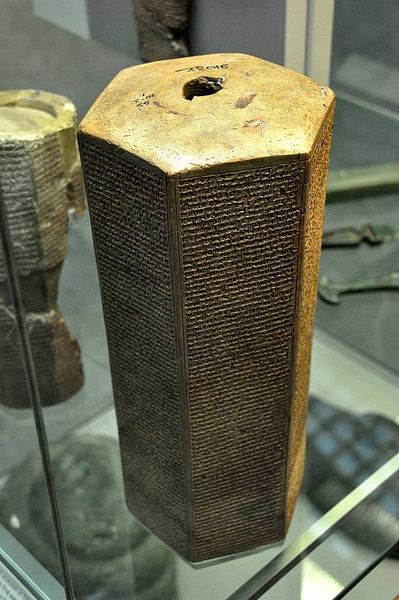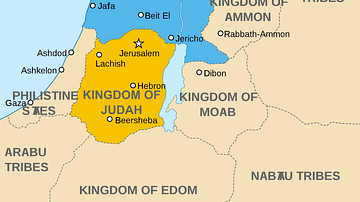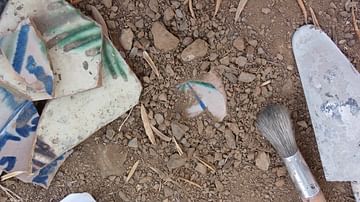The Iron Age in the traditional Ancient Near Eastern chronology ranges from somewhere around 1200 BCE to 333 BCE. It begins from the era when it was first thought iron came to be used up to the ascendency of Alexander the Great as the major power of the Ancient Near East. The Iron Age is categorized as the second age following the Bronze Age under the Ancient Times. The categorization of the Iron Age in this chronology is based on the 'Three-Age System' originated by a Danish archaeologist named Christian J. Thomsen in the 1800's. Although iron were already is use in the 3rd millennium, many continue to maintain its validity. For many, the Iron Age should end with the rise of Cyrus of Persia as the major power of the Ancient Near East. Based on the different events that occurred in Israel during that period, the Iron Age should be divided into six sub-categories: Iron Age Ia, Iron Age Ib, Iron Age IIa, Iron Age IIb, Iron Age IIIa, and Iron Age IIIb. To acquire a proper understanding on Israel during this period, researchers ought to value both biblical and archaeological results to establish a more credible reading.
Evidence unearthed from the Ancient Near East starting from 1700's to modern day can be categorized under three general rubrics: 'Archaeology', 'Epigraphy', and 'Literature'. Unfolding the world and life of the antiquity covers more than just mere raw materials but inscriptions and archives. Even in dealing with the world and life setting behind the biblical text, both archaeology and epigraphy do provide some verification to most biblical texts in question. Therefore, archaeology, epigraphy, and literature function in tandem in order to establish a more coherent account.
The Sea Peoples
In Israel, the Iron Age Ia era is identified with the period following the demise of the Hittite and Egyptian empires at the close of the Late Bronze Age. Artefacts verifying their presence in Canaan have been discovered from excavations of Ashdod and Tel Miqne-Ekron. It was also a period where additional data point to the settlement of Aegean groups (Sea Peoples) who may have been the precursors of the Philistines. Whether the Israelites were part of this group or not remains one hotly debated issue.
In the scholarly consensus, the Sea Peoples is perhaps the most widely accepted theory on how Canaan and the Transjordan came to be occupied. Modern archaeologists were able to prove settlements in Shechem, 'Ai, Bethel, Kh. Raddana near Ramalla, and Gideon through cultural artefacts, houses, grain remains, silos, cisterns, cooking pots, and metal tools dating back to the Iron Age Ia phase. Furthermore, archaeologists were unsuccessful in gathering any archaeological data from the main sites referenced in the book of Joshua such as Gilgal, Jericho, and 'Ai to verify a southern entrance during this phase. Even more, Judges 1 and 1 Kings 9 also support the archaeological surveys. For this reason, Israel's activities during the Iron Age Ia remain a matter of debate between biblical scholars and archaeologists. Importantly, with biblical sources and an Egyptian epigraphy known as the Merneptah Stele (the earliest non-biblical reference to a people called "Israel") point to the Iron Age Ia as when the Israelites first appeared on the scene in Canaan.
The period of Judges
The Iron Age Ib phase in Israel is assigned to the period of the judges, which is marked off by settlements in the area. The book of Judges exposes the life situation in the land of Israel during the Iron Age Ib. Briefly, the period can be described as an uneasy experience for the Israelites politically, religiously, and socially, since an early settlement of a people is always a challenge, especially in a land already occupied by more than one ethnic group. Since judges have controlled Israel for about two hundred years, the Israelites had to deal with two major issues in Canaan: their relationship with Yahweh, and their neighbors.
Monarchy
The Iron Age IIa covers the period of the monarchy up to the 9th century BCE. The Iron Age IIa is clearly marked off from the period of the judges by the establishment of a monarchy at the close of the first millennium BCE. The discovered extensive royal construction works, cities, palaces, fortifications, and the usage of ashlar masonry distinguishes this era from the Iron Age Ib. The Iron Age IIa was the perfect time for the people to appoint a king to ensure protection from external threats since establishing a monarchy would have never become possible if Egypt had been still in control of the area. It would have been considered an act of resistance towards Egyptian control.
The construct of the monarchy was in operation from the reign of Saul, David, Solomon, and Rehoboam. During the time of King David and King Solomon, international relations between Israel and its neighbors were established and Israel's military force and economic stability had reached its peak. Since international relations with foreign nations during King David and Solomon are attested through cultural materials dated to the Iron Age IIa with the neo-Hittite culture, the Canaanite-Phoenician and Egypt, it is viewed quite the opposite by the biblical authors.
For example, the reign of King Solomon is generally perceived as a period of economic stability based on their direct control of the trading routes situated north and south of Israel. In addition, their participation in the international affairs of the Ancient Near East was another source of income due to their agricultural wealth. This was Israel's main exporting asset throughout the Ancient Near East that fed their economy. It was Solomon's foreign marriages including the daughter of a Pharaoh that made all these economical advantages possible for Israel.
On the other hand, these international affairs and the king's foreign marriages were nothing more than mere lust to the biblical authors. The biblical narratives, after a careful reading with an open eye to the social realities of the Iron Age IIa, expose two possible interpretations of Solomon's foreign marriages and international involvement: theological or political. Inevitably, Solomon's foreign marriages were a political move to ensure protection over the monarchy, whereas in the biblical narratives it was a sin. Upon appreciation of the social and political realities of the Iron Age IIa era, one will come to notice that Israel was left with no safer alternative but to build foreign relations and get involve in the international affairs.
Division of Israel
During Solomon's son, the kingdom of Israel was divided into two separate states: Israel in the north and Judah in the south. Though the division had brought peace between the people, external problems were gradually creeping upon Israel and Judah in the 9th and 8th century BCE from Aram and Assyria in the north.

The first conflict took place during the time of King Jehu of Israel and Shalmaneser III of Assyria. Epigraphic evidence called the Black Obelisk, discovered in the 1800's, points to this event. The Black Obelisk depicts King Jehu of Israel and other Assyrian vassals offering their tributes before the Assyrian monarch, Shalmaneser III. Following its discovery and decipherment, the majority of biblical scholars have come to conclude that this was the first time in Israelite history a relation between Israel and Assyria was established.

One other major event of the Iron Age IIa that occurred in around the end of the 9th century or the early 8th century BCE during Jehu's son, Jehoahaz, is partially reflected in II Kings 13 and archaeological survey. King Jehoahaz had to face the consequences of his father's retaliation against the house of Omri that cost Israel losing its allies leaving the kingdom vulnerable to foreign threats. Following the death of Shalmaneser III, the Assyrian empire could no longer hold its subjugated vassals under control, which encouraged Aram to finally take control of Israel. In response to King Jehoahaz's request of Assyrian assistance, Adad-Nirari III, the Assyrian monarch came to the rescue and delivered the Israelites from the Arameans, according to a stele discovered at Tell el-Rima in Iraq.
Assyrian threats
The Iron Age IIb phase includes events of the 8th century BCE, which is generally known as a period of threats from the Assyrians. Evidence of Assyrian terrorization is provided by Assyrian inscriptions of Tiglath-pileser III and Sargon II. The biblical account also mentions these events through II Kings 15, following the failed Syro-Ephraimite War against the Assyrians led by King Pekah of Israel and King Rezin of Syria, and King Hoshea's fickle submission to Sargon II after Pekah.
In response to the Syro-Ephraimitic coalition after King Ahaz of Judah's request of shelter from the constant threats from Pekah and Rezin, and submission to the Assyrian lordship, Tiglath-pileser III and his army marched south to the rescue. This is the first time in Israelite history that Judah became an Assyrian vassal. From these events, archaeologists successfully unearthed layers with pottery shards in them dating to Tiglath-pileser III's destruction of Israel. As a result, both the remnants of Israel and the kingdom of Judah were subjugated to the Assyrian rule and were required to pay tribute, while Syria became an Assyrian administration centre.
Israel under Assyrian rule
Major Mesopotamian influence in Israel during the Iron Age IIb is attested by the construction of the Covenant Code found in the book of Exodus. It was between 740 BCE and 640 BCE that the Laws of Hammurabi had already existed in Israel, which became the source for the formation of the Covenant Code. When one compares their structure and content, it is obvious that the author(s) of the Covenant Code had used a copy of the Laws of Hammurabi.
Another memorable interaction of the Iron Age IIb occurred after Hoshea, King of Israel, had been found guilty of treachery by sending tributes to the Egyptian Pharaoh instead of the Assyrian Monarch as usual (II Kings 17). The disloyalty was generally understood as an act of resistance in the antiquity, which angered Sargon II, the Assyrian monarch of the time, and forced his presence in Israel, which led to Israel's first exile into Assyria ca. 722 BCE as depicted in some inscriptions.
The conflict that took place during the time of King Hezekiah of Judah and the Assyrian monarch Sennacherib (704-681 BCE) is also worth mentioning. It is recorded in four different accounts: Isaiah 36-37; I Kings 18; the Sennacherib Prism, and by Herodotus, the 5th-century Greek historian. During this phase of the Iron Age in Israel, Assyria was still the major power throughout the Ancient Near East and Jerusalem was still paying tribute to the Assyrian empire.

The prolonged heavy taxation to Assyria had caused deep frustration amongst the people of Judah and they sought Egyptian alliance to end this. Upon receiving word of this new Egyptian alliance, destruction on the southern kingdom was impending. Sennacherib, the Assyrian monarch at the time led a punitive campaign ca. 701 BCE, described in the book of Kings and Sennacherib's own account known as the Sennacherib Prism. The prism, originally written in Akkadian, indicates that the Assyrian monarch had besieged Jerusalem and deported numerous people including their animals, about 200,000 in total.
The demise of the Assyrian Empire
The Iron Age IIIa phase began with the reign of King Manasseh in the 7th century BCE. As described in the book of Kings, King Josiah had carried out his national restoration and expansion of the kingdom following the death of the Assyrian monarch, Assurbanipal. Internal conflicts in the empire resulted in the Chaldeans taking control of Assyria under Nabopolassar, and Judah was again left in peace, for a short period. This is supported by archaeological evidence: an increase in sites and the expansion of Judean settlements in the Judean and Negev desert margins.
Babylonian exile
The final phase of the Iron Age in Israel is categorized as the Iron Age IIIb dealing with the Babylonian exile and its aftermath. Textual and archaeological evidence such as excavations at Gibeon, Mizapah, and Bethel, and the appointment of a Judean governor as a Babylonian watchdog over Jerusalem account for this period. Despite the fall of the Temple by Nebuchadnezzar II and the exile of the people to Babylon, life still went on in Judah. The effects on Jerusalem in the aftermath of the Babylonian attack were minor. Family life, cultural traditions, economic production, values, and ideological perspectives remained alive despite the removal of the elite groups from Jerusalem.
Conclusion
Archaeologists and biblical scholars attempt to unravel the relationship between Mesopotamia and Israel during the Iron Age based on the rich source of information deriving from biblical and non-biblical materials and archaeological discoveries. Diverse data assessed above suggest that though the relation was not a serene one, it has heavily influenced Israel in many ways. Not only its political structure but its legal and religious system show numerous influences as well. For example, the manners of the king in Israel as narrated in the book of Samuel is paralleled to an Akkadian document exhibiting the rights of a king; their civil laws being similar to the Code of Hammurabi. Various myths in the Hebrew Bible/Old Testament also reveal some influence from Mesopotamian mythology.
Assyrian monarchs and their military force present in Israel throughout the Iron Age, Mesopotamian literature flourishing around, and Israel being involved in the international affairs of the Ancient Near East all had an impact on the political and religious system. Throughout the Iron Age Israel has never escaped Mesopotamian control for more than three centuries. Though the Israelites have shifted from theocracy to monarchy, there was never a time in Israel's history when they became a major power in the Ancient Near East. They remained submissive to the major powers around. Obviously, Israel's geographical location in the midst of Egypt to the south-west, Mesopotamia to the north-east, and Syria to the north was a disadvantage. All these powerful nations have had impacts on Israel during the Iron Age, but the one that had enormous influences on Israel was Mesopotamia.







